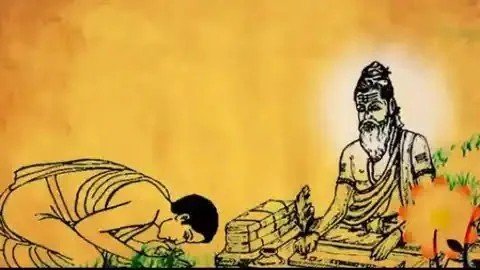
“If I were to look over the whole world to find out the country most richly endowed with all the wealth, power, and beauty that nature can bestow—in some parts a very paradise on earth—I should point to India. If I were asked under what sky the human mind has most fully developed some of its choicest gifts, has most deeply pondered on the greatest problems of life, and has found solutions of some of them which well deserve the attention even of those who have studied Plato and Kant—I should point to India. And if I were to ask myself from what literature we, here in Europe, we who have been nurtured almost exclusively on the thoughts of Greeks and Romans, and of one Semitic race, the Jewish, may draw that corrective which is most wanted in order to make our inner life more perfect, more comprehensive, more universal, in fact more truly human, a life, not for this life only, but a transfigured and eternal life—again I should point to India”, said renowned Indologist Friedrich Max Müller in his lectures to the British civil servants delivered at the Cambridge University on the subject: “India: What Can it Teach Us?”.
The literature capable of transforming the inner life of humans that Max Mueller talked about was the ancient Indian classics like Vedas, Upanishads, Puranas and Itihasas (Ramayana and Mahabharata). They were in a way the world’s ancient-most literary works dealing not only with the divine but also the mundane. The earliest compiler and author of some of these eternal works of knowledge and wisdom was Krishna Dwaipayana – popularly known as Vyasa.
He was dark skinned and was born on an island, hence sage Vyasa was called Krishna Dwaipayana. He is considered as the Adi Guru – the first master. The full moon day – Purnima – in the Hindu calendrical month of Ashad, which falls on 24 July this year, is considered as the birthday of the great sage, and hence called as Vyasa Purnima. On this auspicious day, Hindus worship their Gurus as a mark of respect for the knowledge and wisdom they bestow on mankind.
Sage Vyasa was a ‘Kaarana Janm’ – meaning ‘born with a purpose’. His birth was a result of the association between Sage Parashara and a fisherwoman Satyavati. Vyasa’s mission in life was to codify the ancient knowledge of the innumerable saints and sages of India, which he performed with the help of Ganesha. Thus were born the Vedas. Vyasa was also the author of the great epic Mahabharata, of which the Bhagavad Gita, described by Sir Edwin Arnold as the ‘song celestial’, was also a part.
Vyasa was the progenitor of the living Guru tradition of India. Gurus in India are not just teachers or preachers that one finds in other religions. They are the masters who epitomise the wisdom that they transmit. A teacher teaches, but a Guru lives.
Muslim writer and philosopher of British India, Muhammad Iqbal, who was also regarded as the father of the idea of Pakistan, had highlighted an important dimension of the Indian civilisation in his famous poem: ‘Sare jahan se accha Hindusta Hamara’.
“Yunan-o-Misr-o-Roma Sab Mit Gaye Jahan Se, Ab Tak Magar Hai Baki Naam-o-Nishan Hamara, Kuchh Baat Hai Ke Hasti Mit’ti Nahin Hamari, Sadiyon Raha Hai Dushman Daur-e-Zaman Hamara”
“The Greek, Egyptians and Romans have all vanished, but we are still here. There must be something special that we still exist despite the whole world against us” – he wondered in that poem.
The eternality of the Hindu culture and civilisation that surprised Allama Iqbal can be attributed to the tradition of the living Gurus. Unlike in other religious traditions, the Gurus in Hindu tradition have the authority to not just transmit but interpret the ancient civilisational wisdom for the present times. They are the link between the Sanatan – eternal knowledge – the great ancient wealth of timeless wisdom and the generations of ever-changing social order.
The true Guru is the repository of the knowledge of the divine as well as the mundane. God in Hinduism is not a creation of mere intellectuals. God is the eternal reality. Divinity is all-pervasive and omnipresent. The Guru is the medium to realise that eternal reality. He or she helps in exploring that reality depending on the level of one’s intellectual calibre. The Vedas are the highest form of the expression of that reality. The Hindu can delve deep into that knowledge through persistent questioning and reasoning. Not blind faith, but intelligent exploration is the way to that eternal reality in Hinduism. You should not be a mere ‘believer’, but be a ‘seeker’, Hinduism advocates. The Guru will help in satisfying that intellectual urge and curiosity to move closer to the reality.
But the end of that seeking is in ‘Samarpan’ – dissolving into that reality. The Guru is the epitome of that profound quality of Samarpan. That is the ultimate state of realising the divine. Reaching there requires not just devotion, but courage. God in Hinduism is available to only those who have the courage to discard everything mundane. The weak will seek resolution for mundane challenges from the Guru. But the courageous seek from the Guru the path to dissolving into the divine reality.
Guru Purnima is the day of that Samarpan. Samarpan is a higher quality than virtues like Dana – donation and Tyaga – sacrifice. Dana is about offering what is extra to you. Tyaga is about offering something in return for name and fame. Samarpan is when one is ready to completely merge oneself with the ultimate reality forgetting everything else. Through the Guru Puja – worship of the Guru, one should seek to move closer to the ultimate reality by imbibing the virtue of Samarpan. That is the true meaning of Guru Puja.






Thank you for enlightening through this wonderful write up.Came to know that Samarpan is highest than Dana and Tyaga.
Regards,
Good exposition of the concept of Guru.
Should be part of school curriculum
the chintan foundation may slove a long-standing puzzle about how some of the biggest true worship !
Call of the foundation: india proposes first-ever snow true worship survey !
A very lucid and simplified piece on the Hindu concept and role of guru. I wish the entire Hindu philosophy were presented in a small, lucid and facile manner as this one. It would immensely help in disseminating a clear understanding of Hindu concepts among the younger generation of Indians and others.
Yes, gurus of the yore were good. They imparted true knowledge and divinity. The spiritual gurus (teachers) or shishyas (students) of today are nowhere near. The value-system of the ancient times should come back, though in accordance with the present time and understanding.